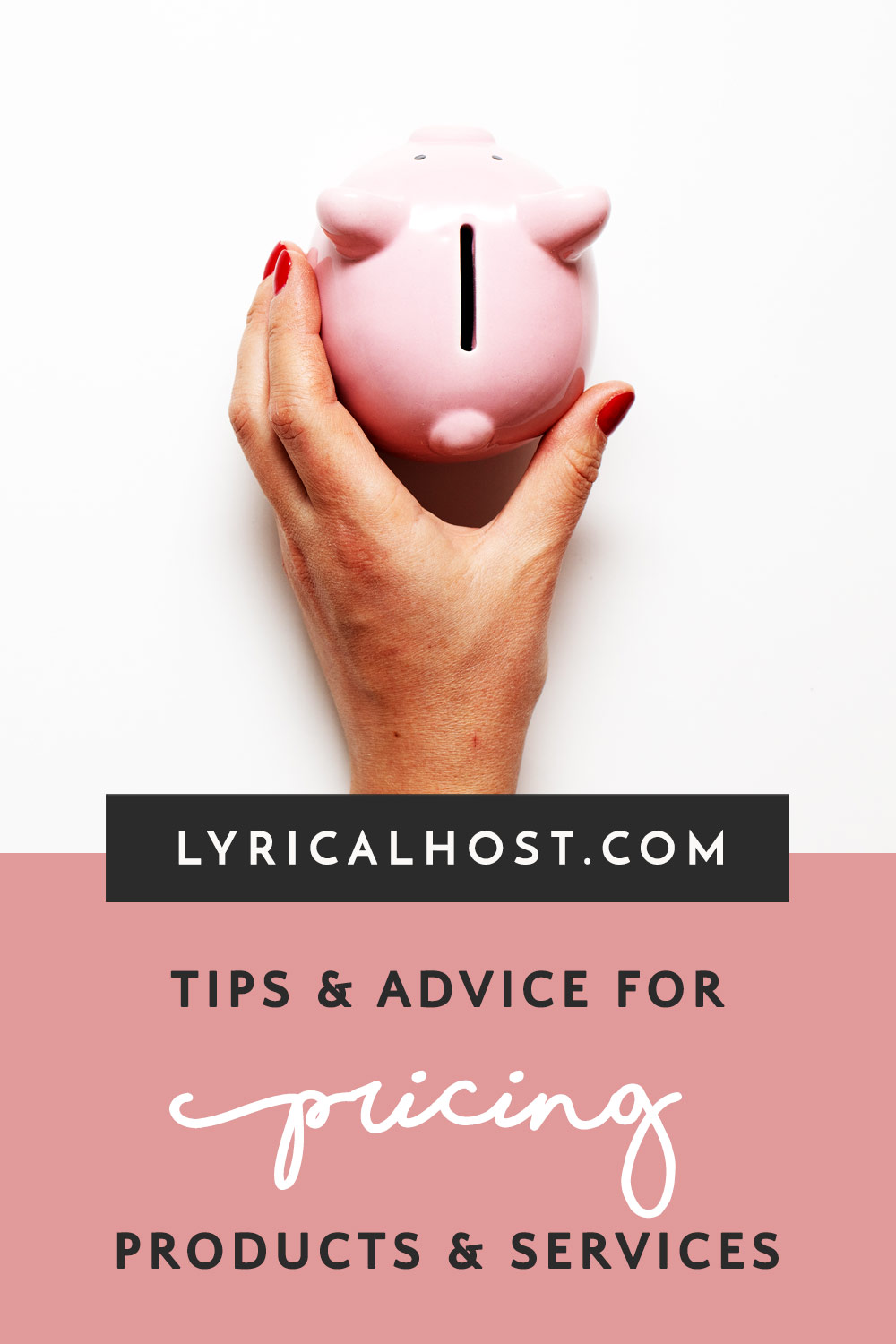We host all kinds of blogs and businesses at Lyrical Host, but there are a bunch of questions that come up regularly when people are thinking about pricing (or changing the pricing) of their products and services.
Below we’ve included our tips and strategies for the most common questions we see. Before you get stuck in, it’s important to note that there are not necessarily specific right or wrong answers or approaches; people prefer different things and find that one approach works much better for them than another. That’s totally okay too – whatever works best for you!
Expect to go into it and not get things right first time. No matter how much advice you get on pricing, it’s usually one of those things where you end up making the classic mistakes you’ve read about at least once or twice! Definitely don’t beat yourself up about it, just take what you’ve learned from the experience and move on.
This post covers a range of different things, including how to charge and what to charge, beating feast and famine cycles, pricing across different platforms, structuring your offerings, working for shares or commission, and much more.
Let’s get started!
Should you price low or high ticket?
Whether you choose to price high or low, there are aspects that work in your favor and aspects that don’t. A lot of people strongly favor one specific model over the other, but the reality is that both have their own advantages and disadvantages. It will depend a lot on what you’re selling and who you’re selling to.
Examples of low volume/high ticket businesses include things like one-to-one coaching or strategy, bespoke web design, SEO consultancy, unique art, and similar. The buyer usually gets a product or service that’s specifically tailored to them, and pays a premium for it.
Examples of high volume/low ticket businesses include things like stock photo memberships, web hosting (hi!), fonts and other premade design elements, printables, fast food, and so on. This model is most effective when there’s a broad appeal for what you’re offering, and people have a strong reason to be a returning customer and/or it’s a recurring subscription-based service.
High volume/low ticket advantages:
✔ Your risk is spread wide. If one client cancels a subscription or doesn’t order from you again, it’s not a devastating hit to your bottom line.
✔ Lots more people means you have a bigger pool of people recommending you to their friends.
✔ Often less mission-critical for people, so it’s less pressure as the stakes are lower, e.g. you’re providing stock photos vs being directly involved in their business or life.
✔ You can potentially impact a lot more people.
✔ For subscription services, for example product boxes or virtual memberships, you can build a pretty consistent recurring income without feeling like you’re starting over from scratch every month. This also makes it easier to plan and budget for other things in your business such as equipment and team costs.
✔ An easier “yes” for people (in most cases they don’t have to think about it, save up for it, talk it over with other family members, etc.).
✔ It’s usually more passive or doesn’t require you personally as much (you can grow and delegate to team members).
Low volume/high ticket advantages
✔ You don’t have to worry about finding and converting large numbers of people (this is a big one for a lot of people, which is why many start out with this business model and later transition or create a hybrid approach).
✔ Less customer service management (for things like mailing out orders, helping people access their account, etc.), which means more time for the things you enjoy and that make an impact.
✔ You can tailor and change your offerings on a whim depending on what you feeling like doing or pivoting to (you don’t have stock or a specific long-term expectation/requirement of an specific ongoing service).
✔ It’s often working one-to-one, so building close relationships with people and experiencing how what you do impacts their lives.
✔ It can potentially earn more money sooner (as you’re not waiting on your income to build up across a lot of clients), which allows you to plan ahead for inconsistent times.
✔ Can help you build your personal brand at the same time, so that subsequent businesses have a value with your own name attached to them.
Opting for a hybrid approach
You don’t have to just pick one model; you can create a hybrid approach. For example, you could have a high ticket/low volume coaching service and a low ticket/high volume ebook. This could be one you recommend to your coaching clients to boost sales a little, use to attract potential coaching clients, or something that’s for a totally different audience altogether.
A hybrid approach means that you can cater for a wider variety of price points and manage your work life balance more easily. It can also help you beat feast and famine cycles if you integrate passive income, which we look at later in this post.
When thinking about going high or low ticket, here are some things to consider:
How big is your target market/audience likely to be?
If it’s something all mamas would buy, you could go low ticket. If it’s highly niche and specific, a low ticket model is much less likely to be successful because you won’t get the volume of sales.
How scalable is your product/service?
You can price lower when you can take on a lot of customers, e.g. a non-personalized social media template subscription.
What medium are you working with? For example, there’s always going to be a ceiling of what people will pay for an ebook, but they’re likely to pay more for a complete toolkit or a one-to-one program, or something that has extra value added in the mix such as personal support.
What does the competition and market look like?
Although you want to set your own pricing, knowing what people expect to pay is also important. For example, people don’t want to pay a premium for web hosting but expect a lot as standard, such as excellent round the clock support, great high end hardware, and other extras. Someone may be absolutely obsessed with the bath bombs you make, but that doesn’t mean they’ll pay $50 for one.
What outcomes and benefits someone is likely to gain from your product or service?
For example, if your product is a business course that people can use to grow their own business, they’re likely to invest more in that than a home cookbook, which of course is still useful and wonderful, but doesn’t have the same return on spend.
How does the specific product or service you’re pricing fit into your overall business and long term picture?
If your product or service is entry-level and designed to test the waters, it may even be partially free, fremium, or involve a demo, and be used as an upsell or cross-sell to more expensive things. If it requires someone to commit, for example it’s an in-depth course or training program, the price is likely to be much higher. If you run events, webinars or workshops, it may be that you offer a very small price for tickets, such as $5, to secure someone’s commitment.
How different is your product or service to what’s already out there?
Uniqueness can also demand higher pricing. If someone wants to work specifically with you and only you, or if you offer something no one else can, for example art. Be cautious of selling expensive products that aren’t unique (especially online), unless you can think of your own unique selling points and the reasons why someone would choose to buy that from you vs another seller.
What’s a realistic number of sales for you?
Think about what number seems realistic for you to sell to do the math. For example, if you expect to sell 500 ebooks, pricing them at X means your gross profit will be Y. If you expect to sell 20 ebooks, you would need to price them at Z to get the same gross profit. Your estimated sales numbers will largely be guesswork at the beginning until you get a feel for what you can do and build up an audience.
Will you offer payment plans or another way of breaking down payments? If so, that can potentially be more manageable for people that a big lump sum upfront.
“Price what you’re worth” vs. value-based pricing
Price what you’re worth is a popular sentiment, but it may not be the route you want to go down for a few reasons.
Firstly, calculating what to charge based on your worth is primarily based on your own lifestyle. Someone isn’t buying from you because they want to pay your bills or student loan – they’ve buying because they want something for themselves. It’s about them.
Secondly, how are you putting a number on a human being’s worth? If you’ve decided it’s $50 an hour, why is it not $55? Or $60? Or $600? Or $5000? It’s just a random number, or a number based on other calculations such as what you think people will pay, which isn’t related to your worth.
Having said that, there’s one way you can calculate your worth – by calculating it to other people. From this perspective, it becomes more about value-based pricing.
Your worth is different to different people/companies, even for the same skills. Disney will pay you a lot more than a mom and pop store, because they can get a much bigger return on their money. This doesn’t mean you should only try to work with big companies, it means that you need to adjust where you’re at for working with different types of people, or it means that you need to adjust your strategy, for example you may want X number of mom and pops for every one “Disney.” Alternatively, you can find other ways to work with people that increases the income for you while still remaining affordable for them, for example by running a group workshop instead of a one-to-one, or creating semi-exclusive or PLR content rather than exclusive unique content for bloggers.
It’s not your duty to calculate your own worth for a person or business; that’s their job. But, at the end of the day, that doesn’t mean they’ll automatically know or be able to judge your worth to them, and their judgements can be affected by all kinds of things, from what they’ve read in a Facebook group to what someone else has quoted. Additionally, you want to think carefully about the outcome you’re planning to deliver for the person or business in question, without overpromising. Is what you’re offering a “want,” a “need,” or both? Is what you’re offering likely to make that person money or improve their health, either directly or indirectly? People are willing to pay more to solve what they see as a big problem or potential cause of high stress.
If you’re a service provider, it’s likely that you’re also providing strategies and takeaways that people can put into practice without you. This is why it delivers value but it doesn’t become an hourly rate for your services, because the actions continue beyond you. However, you could potentially offer a retainer or occasional support program or call to keep some income coming in.
If you’re a product creator, you can use upsells and cross-sells to increase basket value. This can also include things like mystery boxes and minimum spend for free delivery. The value the customer gets increases the more they purchase at one time, and it’s less mail admin for you.
You can also use the questions in the previous section above to get a ballpark idea of what kind of levels you’re happy working at. In the next section of this post, we look at different ways of charging.
Should you charge an hourly rate or a fixed project rate for services?
Similarly to how much to charge, people are usually very emphatic in their views on whether you should charge by your time or at a fixed rate. And similarly to before, there are pros and cons to both options, and what you choose will also depend on what you offer to some degree.
Tasks that are very predictable are easier to tie to a project rate. For example, if you write and schedule social media posts for a client, you can work out roughly how long it takes you to schedule one post and develop a cost for XX posts based on that. This gives you more flexibility in what you charge, allows you to build more profitable packages, and means you aren’t charging less than someone who works slower than you and/or is less experienced.
Tasks that are unpredictable often work better tied to an hourly rate. For example, if you’re a developer fixing an issue, or a web designer doing a highly custom job, it may be very difficult to gauge exactly how long everything will take, or something may run very far over its time (especially if it requires working with a third party). In-house contractor work can often be more profitable when charged hourly for the same reason, especially for large/long projects; if you’re waiting on someone else in a team, or there are long meetings you’re required to attend, you’re still getting paid for those. If you’re going down this route, a time tracking tool such as Toggl (free), RescueTime or Harvest is a must so you don’t forget any billable hours and can keep track of time spent on different clients.
One alternative to this, or to make sure you get paid, is to work on a project milestone basis. Using this method you would break down the project into multiple stages and arrange a sign off of the work complete and payment for that stage. This can also be a way to make your services more affordable for people who may be concerned or unable to pay big lump sums. It also means that if they don’t pay or have problems, you know about it much earlier on.
Working for free, bartering, commission, and shares
This is often done by people just starting out, especially if they have a portfolio they want to build up. Instead of working for free, it may be worth looking at offering a discount or bartering; see Using Bartering To Overcome Your Skill & Budget Gaps for more on this. For example, if you’re a web designer, you may want to design a photographer’s website in exchange for headshots or photos you can use for mockups. If you’re a product creator, you could get your products into physical or virtual bundles or subscription boxes for a heavily discounted rate, for free, or in exchange for social media or email list coverage.
People who are getting your services completely free of charge may be more demanding or not see the value or appreciate them as much. They may even decide to ditch it altogether or not be super enthusiastic, so it can have a disheartening effect.
If you’re a service provider in sales, coaching or similar, some people adopt a commission route. This can sometimes work out really well, or it can go the other way and be a disaster. Rather than working on a commission-only basis, it could be that you want to have a base rate or fee, and then commission is added on top. As great as your marketing or development or assisting skills are, the product/service and the business itself play a huge factor in your success, and that’s not your reponsibility or something you have control over.
Working for shares is another potential route to go down. For something like this, especially for shares-only situations, it’s best to get legal advice and a review of the proposed contract. This is because you may never see any money even if the company is successful, and if it’s not people may move on to other things and take advantage of legal loopholes to avoid paying you. A huge red flag is if someone says to you, “I’ll pay you when the business makes money.” You still deserve payment for the work you’ve done.
Beating feast and famine cycles
One thing that’s very common, especially for freelancers, coaches, and those with seasonality to their products, is that you can get caught in a feast and famine cycle.
This is where you may make a ton of money one month and very little the next. This becomes a problem when you have multiple months where you’re not making the money you need to or you’re living hand to mouth. An unexpected bill or your car failing at the wrong time, and you can spiral into a bad place very quickly.
Furthermore, it’s not always as simple as setting aside a large chunk of money in “sunny” months, because this ends up already being earmarked to cover past quiet months, or investing in your business, or even just that you’ve felt deprived for so long you deserve a treat now the money’s come in.
If you’re a Lyrical Host customer, there’s a download in the Resource Library called “What To Do In Quiet Periods” that you may find useful.
One of the best ways to avoid a feast or famine cycle is to develop other income streams to tide you over.
This could be by creating a more passive product – if your work is digital this could be something like a set of onboarding templates or whitelabel tutorial videos that other freelancers can buy, or digital art prints, or creating a carefully researched blog post for affiliate commission. If your work is normally physical, then something like a guide, checklist, workbook, coloring sheets, or other digital product that you can sell in bulk and automatically deliver could work well.
Check out our post Simple Ways To Sell & Deliver Digital Products for more on selling online.
It’s rare that “passive” income is truly passive, but it can be minimal work compared to what you normally do. This can also take the pressure off you for taking a break or a vacation, if you still know you’re very likely to have some money coming in. Recurring income for retainers or monthly subscriptions can all add a lot to your bottom line too.
Alternatively, you could top up your income with a part time or contract role. Some people prefer this as it gives them the chance to work on something entirely different and/or meet new people. There are job recruitment companies that specialize in contract, part time and short term placements, or you can look for advice/work from Facebook groups, tapping into Twitter and so on. Business and blogging groups will often post opportunities (if you’re a Lyrical Host customer, there’s a list of great groups you can download from the Resource Library).
Pricing across different platforms
If you’re selling your products or services in different places, for example your own website, eBay, Etsy, Creative Market, etc., your profit may be different in different places. There are pros and cons to all ways of selling, for example high traffic third party platforms can get your products in front of more people and offer more payment options, but their fees are significantly higher and you have much less control.
If you price things differently to account for different platform fees, this can also annoy your customers if they see the same thing cheaper elsewhere.
One way around this is to bundle your products or services differently on different platforms. For example, you could offer a pack of three templates as a bundle on one platform, and sell them individually on another. People tend to compare like-for-like or remember what they paid, but are very unlikely to go through all your products in varying combinations and compare them on different platforms.
If you have a preferred way for people to purchase, consider how you can make it more attractive for people to purchase that way, for example a discount code for future purchases, a better value bundle, or providing referral credit or gift cards to use in your ideal way.
What to do if people raise questions about your pricing
If you have a business, you can guarantee that at some point people will want to talk pricing with you. We’ve had simultaneous sales chats with separate people where one has questioned why we’re so cheap at the same time someone else has questioned why we’re so expensive. At the end of the day, it’s all relative and it depends on so many different factors.
If you’re working low volume high ticket, you’re likely to run into more questions or concerns regarding your pricing. This is why you want to be super confident in why you’ve chosen the pricing you have and not just plucked it out of thin air or because you want to have a Caribbean vacation this year. You could include things like past results customers have seen, the commitment aspect, the benefits of anything included (e.g. if they get a free subscription to something or they get a whole bunch of extra bonuses included), an idea of ROI (return on investment), the uniqueness of what you’re selling, and so on, depending on what’s relevant.
If you’re a low volume business, it can be easy to be heavily influenced by one person querying, hesitating or complaining, and think that you need to change something. This isn’t necessarily the case; they’re just one person and someone else may have an entirely opposite view or perspective. For this reason, it’s good to get a much bigger sample of some kind, or potentially look at both sides of the debate yourself through the customer’s eyes.
Sometimes getting advice or input from other bloggers or business owners can be really helpful, and sometimes it works against you; the customer’s perspective will often be different, and other bloggers and business owners sometimes repeat what they’ve heard or what they think they should say. Sometimes it’s genuine feedback that can be really useful, and sometimes it’s someone trying to take advantage of your good nature. It’s up to you how you approach it, and often it’s better to have someone else handle it or to talk it over with, as being a business owner you can often take it too personally if you’re not careful.
Building packages and bundles
If you have (or plan to have) multiple products or services that complement each other, bundling them together can work well in providing the customer with more value while creating a higher price point for you.
Depending on what you do and the cart/payment options you have available to you, you could have people build their own packages, or you could build unique ones for each person. Another option is to offer tiers with fixed items included. You could even do a mystery option.
Having monthly, quarterly, or yearly packages can help you introduce a pretty consistent recurring income stream – just don’t oversell beyond your capacity or commit to something long term before seeing if you can sustain it.
If you’re selling tiered packages, it’s likely you’ll have a low cost option, a premium option, and something in the middle. This allows you to cater for a wider range of price points; some people will always buy your cheapest option, and some will always buy your most expensive. If you have a high volume model, it’s essential to keep an eye on what’s the most popular option and work around that to increase the cost if needed. If you have a low volume model, you’ll want to be very in tune to what aspects of your packages are the most popular, and ensure they’re best represented in the level you want to sell the most of.
If you’re a service provider, consider adding value through passive aspects such as templates, books, pre-recorded videos, checklists and similar. These can help you reduce the amount of one-to-one you’re providing, especially on cheaper packages that have less profit for you. Alternatively, or if you’re a product seller, doing similar for just your more expensive packages is a quick and easy way to add a lot more value for a customer without it being a ton of extra work for you.
When bundling products or services, it can often be tempting to significantly reduce the price compared to buying standalone. If you’re doing this, you’ll want to be careful, especially if you’re providing a one-to-one service, that you’re not pricing in a way that’s unsustainable or will cause you to burn out. For this reason, it may be best to offer surprise extra value or even a thoughtful relevant gift and keep your pricing the same or very similar to start, until you get a feel for how it works.
Limited edition items, whether they’re included in the bundle or offered for a certain value of purchase, can be very valuable and persuasive. Another option is to offer deals for bundling hours or offering discounted gift cards/credit, and clients can choose to spend them how they like.
And that sums up our answers to the most common pricing questions we get! I hope you found it helpful in thinking about pricing your products and services.
Want to come back to this later or share it to help someone else? Pin it:







No Comments